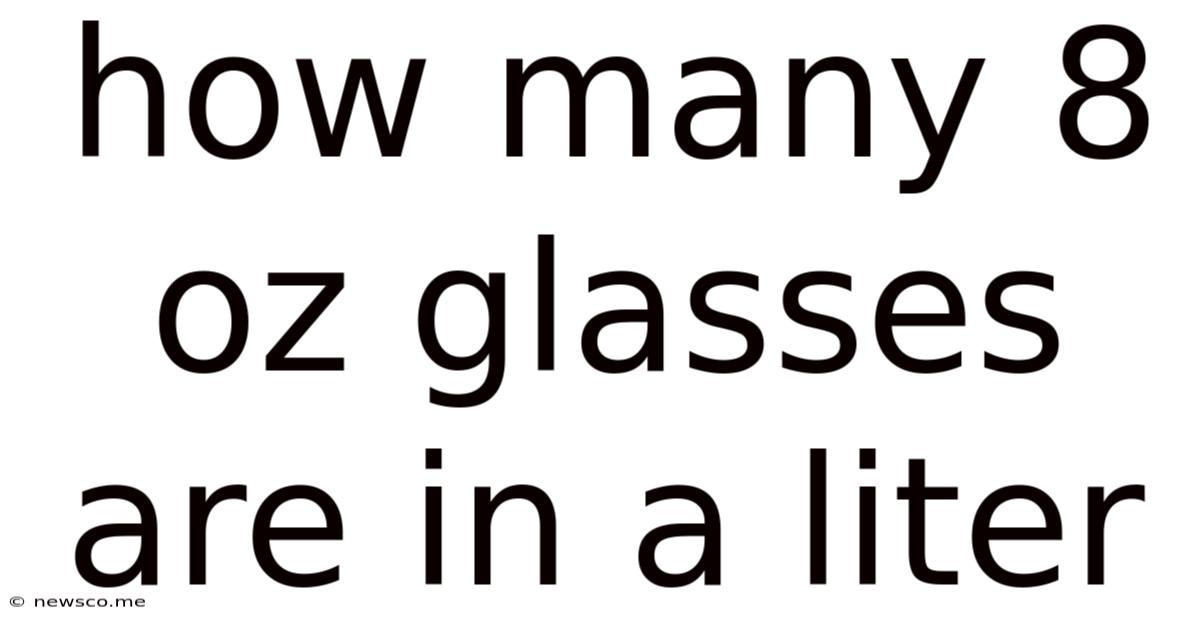How Many 8 Oz Glasses Are In A Liter
News Co
Mar 22, 2025 · 4 min read

Table of Contents
How Many 8 oz Glasses Are in a Liter? A Comprehensive Guide to Fluid Conversions
Understanding fluid conversions is crucial in various aspects of life, from cooking and baking to medicine and everyday hydration. One common question that arises is: how many 8-ounce glasses are in a liter? This seemingly simple question opens the door to a deeper understanding of the metric and imperial systems of measurement and the importance of accurate conversions. This comprehensive guide will delve into this question, explore the intricacies of fluid measurement, and provide you with the tools to confidently convert between liters and ounces in various contexts.
Understanding the Units: Liters and Ounces
Before diving into the conversion, let's establish a firm grasp of the units involved: liters and ounces.
Liters (L): The liter is the fundamental unit of volume in the metric system. It's a widely used unit globally, especially in scientific contexts and everyday life in many parts of the world. One liter is equal to 1000 cubic centimeters (cm³). Its simplicity and decimal-based system make calculations relatively straightforward.
Ounces (oz): The ounce is a unit of volume (fluid ounce) in the imperial system, often used in the United States and a few other countries. It's important to distinguish fluid ounces from avoirdupois ounces, which measure weight. Fluid ounces are commonly used for measuring liquids like water, juice, or milk. The fluid ounce is smaller than a liter, making conversions necessary when dealing with both systems.
The Conversion: How Many 8 oz Glasses in a Liter?
The precise answer to the question, "How many 8 oz glasses are in a liter?", requires a precise conversion. Here's the breakdown:
-
Conversion Factor: One US fluid ounce is approximately equal to 29.57 milliliters (mL). One liter contains 1000 mL.
-
Calculation: First, we need to convert liters to milliliters: 1 liter = 1000 mL. Next, we convert milliliters to ounces: 1000 mL / 29.57 mL/oz ≈ 33.81 oz. Finally, we determine the number of 8-oz glasses: 33.81 oz / 8 oz/glass ≈ 4.23 glasses.
Therefore, there are approximately 4.23 eight-ounce glasses in one liter.
Practical Implications and Considerations
The answer, while mathematically precise, requires some practical interpretation. You can't realistically pour 0.23 of a glass. For practical purposes, you'd typically round this down to four 8-oz glasses. However, it's crucial to understand that this is an approximation. The slight difference arises from the inherent imprecision in measuring liquids, and variations in glass sizes.
Beyond the Basic Conversion: Exploring Different Glass Sizes
The above calculation focuses on the standard 8-oz glass. However, glass sizes vary significantly. Let's explore how this impacts the conversion:
Scenario 1: Larger Glasses (e.g., 12 oz glasses)
If you're using 12-oz glasses, the calculation changes:
- Total ounces in a liter: 33.81 oz
- Number of 12-oz glasses: 33.81 oz / 12 oz/glass ≈ 2.82 glasses. Practically, this means you would need three 12 oz glasses to hold a liter of liquid, with the last glass being only partially filled.
Scenario 2: Smaller Glasses (e.g., 6 oz glasses)
With 6-oz glasses, the calculation becomes:
- Total ounces in a liter: 33.81 oz
- Number of 6-oz glasses: 33.81 oz / 6 oz/glass ≈ 5.63 glasses. Practically, you would need six 6-oz glasses.
The Importance of Accurate Measurement in Different Contexts
Precise fluid measurement is critical in several fields:
-
Medicine: Accurate dosages of liquid medication are paramount for patient safety and efficacy. Errors in conversion can have serious consequences.
-
Cooking and Baking: Recipes often require precise measurements for optimal results. Improper conversions can lead to unsatisfactory outcomes.
-
Scientific Research: Experiments demand accurate measurements for reproducible and reliable results.
-
Hydration: Tracking daily water intake involves conversions, and accurate measurement helps ensure adequate hydration.
Tips for Accurate Conversions
-
Use a Reliable Conversion Tool: Several online calculators and conversion tools provide accurate results.
-
Understand the Units: Be clear about whether you are using US fluid ounces or imperial fluid ounces, as there is a slight difference.
-
Double-Check Your Calculations: Always verify your conversions to avoid errors.
-
Consider Practical Limitations: Remember to account for the practical limitations of pouring and filling glasses. Rounding up or down may be necessary.
Common Mistakes to Avoid
-
Confusing Fluid Ounces and Avoirdupois Ounces: These are distinct units measuring volume and weight, respectively.
-
Using Incorrect Conversion Factors: Ensure you're using the correct conversion factor (approximately 29.57 mL per fluid ounce).
-
Ignoring Significant Figures: Pay attention to the number of significant figures in your calculations to maintain accuracy.
-
Rounding Errors: Be mindful of rounding errors that can accumulate and significantly impact the results, especially in more complex calculations involving multiple conversions.
Conclusion: Mastering Fluid Conversions for Everyday Life
Understanding how many 8 oz glasses are in a liter, and more broadly, mastering fluid conversions, is a valuable skill with wide-ranging applications. While the basic conversion is straightforward, understanding the nuances and practical considerations is essential for accurate and efficient measurement in various contexts, from everyday hydration to scientific research. By employing the tips and strategies outlined in this guide, you can confidently navigate fluid conversions and ensure precise measurements in your daily life. Remember, accuracy is key, and understanding the units and conversion factors is the foundation for reliable results.
Latest Posts
Related Post
Thank you for visiting our website which covers about How Many 8 Oz Glasses Are In A Liter . We hope the information provided has been useful to you. Feel free to contact us if you have any questions or need further assistance. See you next time and don't miss to bookmark.